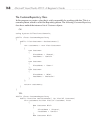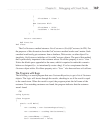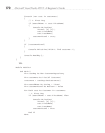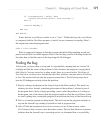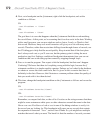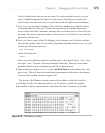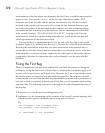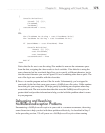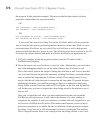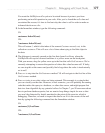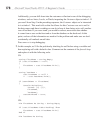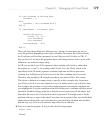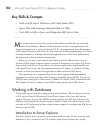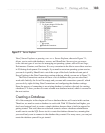
176 Microsoft Visual Studio 2010: A Beginner’s Guide
the program. In this particular example, VS pauses on the line that cleans LastName
properties, repeated here for your convenience:
C#:
var firstName = cust.FirstName.Trim();
var lastName = cust.LastName.Trim();
VB:
Dim firstName As String = cust.FirstName.Trim()
Dim lastName As String = cust.LastName.Trim()
If you recall, the reason for calling Trim on the FirstName and LastName properties
was to clean the data prior to performing further operations on that data. While we were
concerned about FirstName, we also called Trim on LastName as well to help protect
against invalid data there too, just to be safe. The following steps show you how to use VS
to analyze the current situation and make an effective decision on an appropriate fix.
1. If VS isn’t running, restart the program and let it run until VS pauses with a
NullReferenceException.
2. Hover the cursor over cust.LastName to view the value. Alternatively, you can look in
one of the debugging windows to see the value. Observe that LastName is null.
This is the critical point in the analysis, finding the value that is null. It was clear that
cust is not null because the previous statement, cleaning FirstName, executed without
error as verified by inspecting the firstName variable. This example makes it very
easy to find the null value because it occurred on the line where VS paused. In more
challenging situations, you could be passing an object to a method in a third-party
library where you don’t have the code and VS will pause on the line with the method
call. In that case, you have to inspect the values being passed to the method to see if
any are null.
Once you’ve found the null value, you must understand why the code raised the
NullReferenceException error. A null value is the absence of a value; nothing is
assigned to the variable. If you try to reference a variable with null assigned to it, you
will receive a NullReferenceException. This makes sense because you are trying to
perform an operation on a variable that has no definition. In this particular example,
LastName is null, but we’re still referencing LastName by calling the Trim method.
This is illogical because there is not a string to trim; the string variable is set to null.



